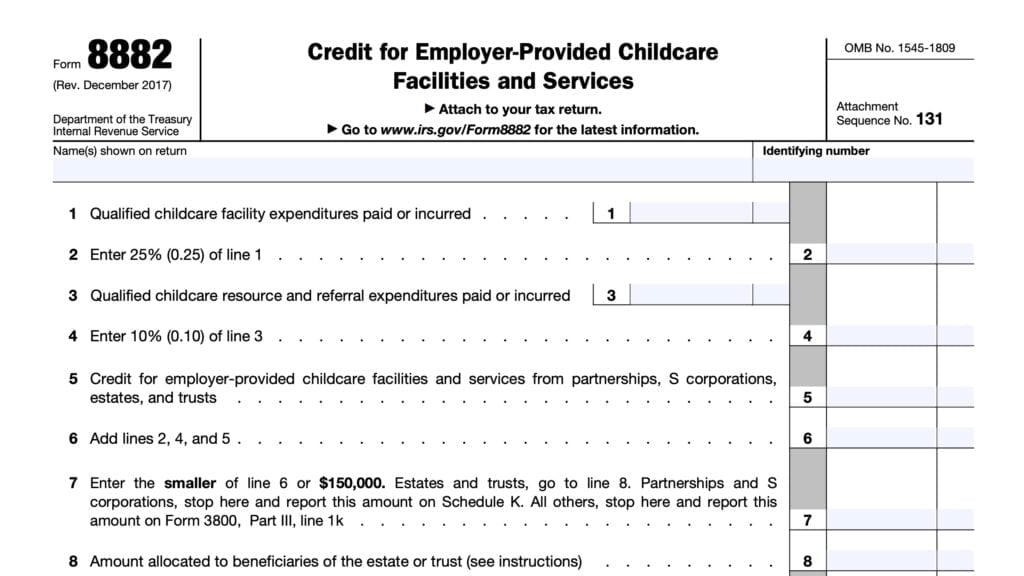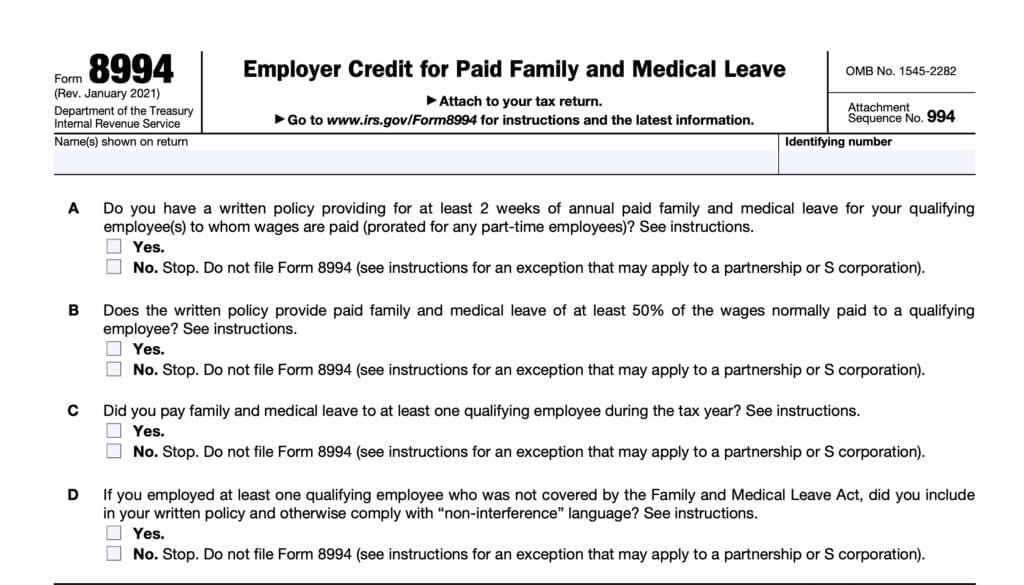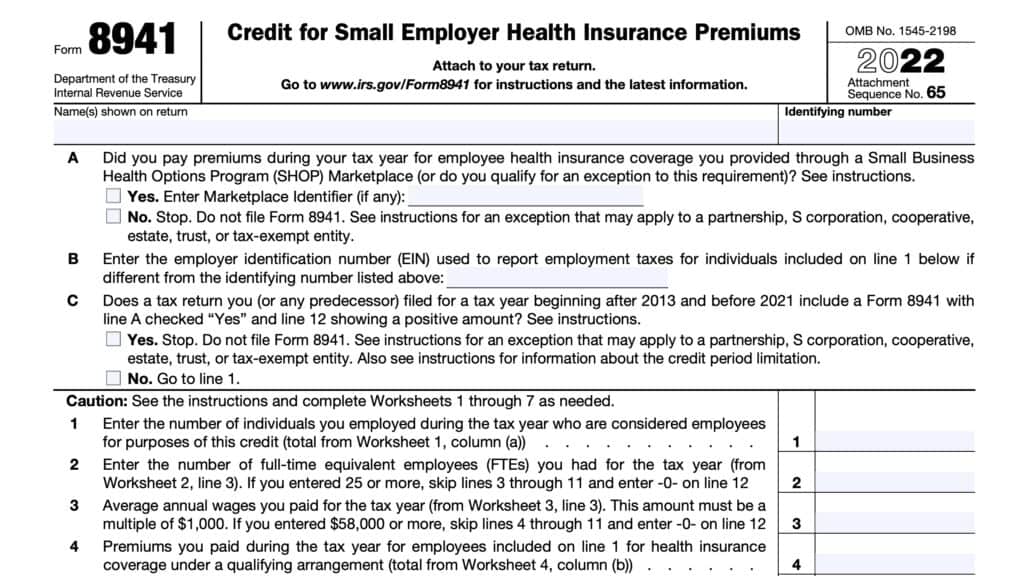IRS Form 944 Instructions
If you’re an employer who pays wages and compensation that are subject to federal tax withholding or payroll taxes, then you may need to report wages and withheld taxes on IRS Form 944, Employer’s ANNUAL Federal Tax Return.
In this article, we’ll help you better understand everything you need to know about this tax form, including:
- How to complete IRS Form 944
- Filing considerations
- Frequently asked questions
Let’s begin with step by step guidance on completing IRS Form 944.
Table of contents
How do I complete IRS Form 944?
There are 5 parts to this three-page tax form:
- Part 1: Answer these questions for this year
- Part 2: Tell us about your deposit schedule and tax liability for the year
- Part 3: Tell us about your business
- Part 4: May we speak with your third-party designee?
- Part 5: Sign here
Before we start with Part 1, let’s take a look at the taxpayer information fields at the top of IRS Form 944.
Taxpayer information
Top Of Form
At the very top, you’ll include information about the employer, as any specific situations about the employer.
Employer Identification Number
In this field, enter the 9-digit employer ID number, or EIN, for the business. If you do not already have an EIN, you may apply for one online through the IRS website or by filing Form SS-4, Application for Employer Identification Number.
Do not enter your Social Security number (SSN) or individual taxpayer identification number (ITIN) in this field.
Name
Enter the name that you used when applying for your EIN. If you are a sole proprietor, you may enter your personal name here, then enter the name of your business under Trade Name, below.
Trade Name
If applicable, enter your trade name here. If your trade name and the name you used to apply for your EIN are the same, then leave this field blank.
For example, Ronald Jones is a sole proprietor who operates a business called Ron’s Ice Cream Shop. Ronald would enter her information as follows:
- Name: Ronald Jones
- Trade name: Ron’s Ice Cream Shop
Address
Enter your business address here. Include the following information:
- Street name and number
- Suite or room number, if applicable
- City, state, and ZIP code
If your business is located in a foreign country, then enter the foreign country’s name, province or county, and postal code in the space provided.

Change Of Business Name, Address, Or Responsible Party
Immediately notify the IRS if you change your business name, business address, or responsible party. You can do this in one of two ways:
- Write to the IRS office where you file your returns to notify the IRS of any business name change.
- Complete and mail IRS Form 8822-B, Change of Address or Responsible Party – Business, to notify the IRS of a business address or responsible party change.
- Don’t mail your completed Form 8822-B with your IRS Form 944.
Now that you’ve entered the employer information, let’s take a closer look at Part 1.
Part 1: Answer these questions for this year
In Part 1, we’ll answer a series of questions that will help us determine the overall tax liability for the tax year. Let’s start with Line 1.
Line 1: Wages, Tips, And Other Compensation
Enter the total amount of wages paid in the tax year, based upon each employee’s wages reported on IRS Form W-2, Wage and Tax Statement.
Sick Pay
Include sick pay paid by your agent as part of total wages. Also include sick pay paid by a third party that isn’t your agent (such as an insurance company) if:
- You were given timely notice of the payments, and
- The third party transferred liability for the employer’s taxes to you
If you’re a third-party payer of sick pay and not an agent of the employer, do not include sick pay that you paid to policyholders’ employees here if you gave the policyholders timely notice of the payments.
Section 6 of IRS Publication 15-A, Employer’s Supplemental Tax Guide, contains more information about sick pay reporting and the procedures for transferring the liability to the employer.
Line 2: Federal income tax withheld from wages, tips, and other compensation
Enter the total federal income tax withholding, or the amount that the IRS required you to withhold, from your employees on all of the following from this quarter:
- Employee wages
- Employee tips
- Taxable fringe benefits
- Supplemental unemployment compensation benefits
Do not include income tax that a third-party payer of sick pay withheld, even if you reported it on Form W-2. You will reconcile this difference on IRS Form W-3, Transmittal of Wage and Tax Statements.
Also include any excise taxes that you were required to withhold on golden parachute payments, in accordance with Internal Revenue Code Section 4999.
If you’re a third-party payer of sick pay, enter the federal income taxes that you withheld (or were required to withhold) on third-party sick pay here.
Additional Information
IRS Publication 15-B, Employer’s Tax Guide to Fringe Benefits, contains additional information on the employment tax treatment of fringe benefits. For information about supplemental unemployment compensation benefits and golden parachute payments, see Section 5 of Pub. 15-A.
Line 3
If no wages, tips, and other compensation listed on Line 1 are subject to Social Security or Medicare tax, check this box and go to Line 5, below.
If this question doesn’t apply to you, leave the box blank.
For more information about exempt wages, see Section 15 of IRS Publication 15, Employer’s Tax Guide. For religious exemptions, refer to Section 4 of Publication 15-A.
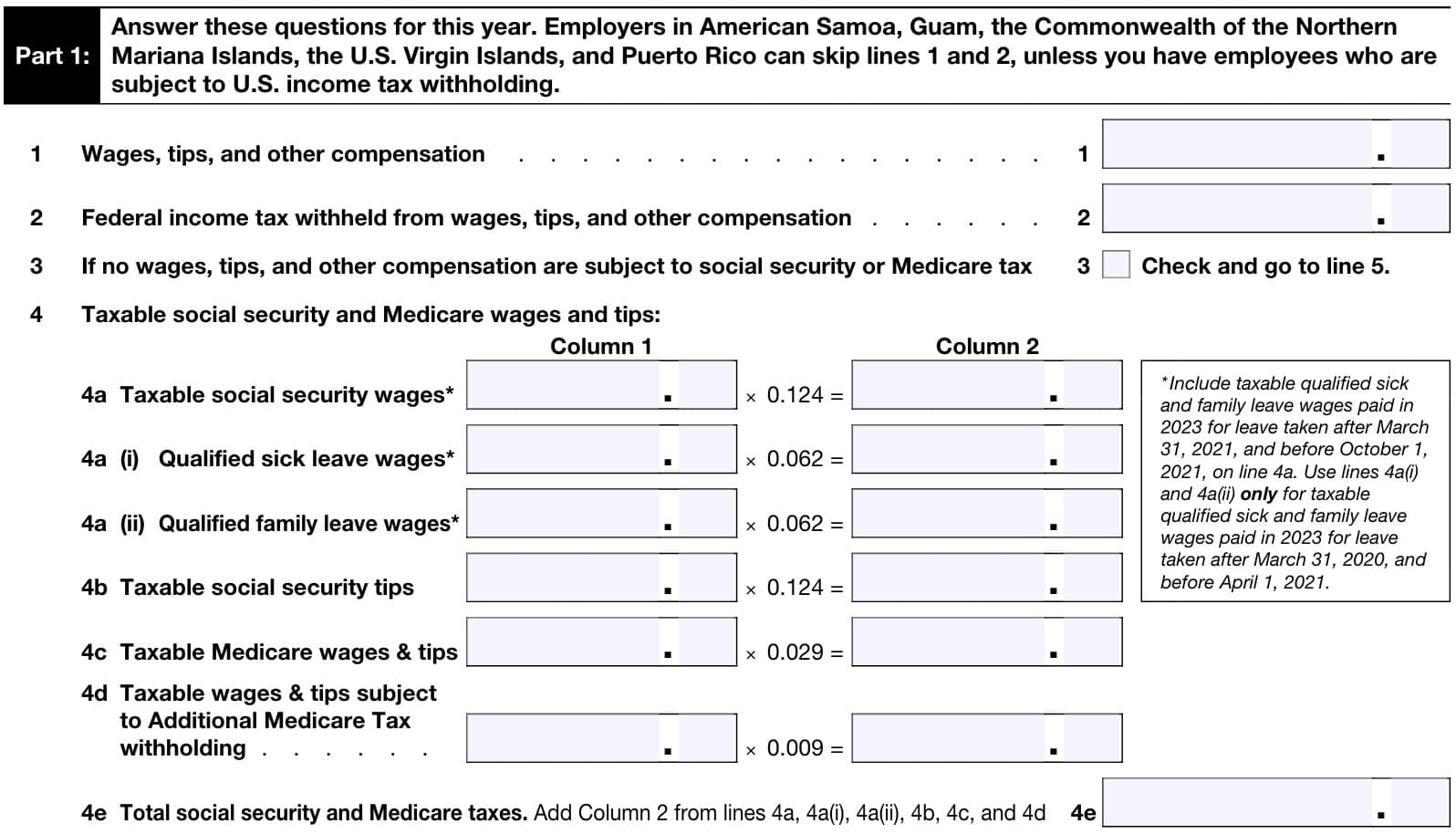
Line 4: Taxable Social Security and Medicare wages and tips
In Line 4, we’ll calculate the total amount of Social Security taxes and Medicare taxes (also known as FICA taxes) on employee income. We’ll break this down beginning with taxable Social Security wages in Line 4a.
For each item in Lines 4a through 4e, follow these steps:
- In Column 1, enter the applicable employees’ wages, tips, or other income
- Multiply the Column 1 number by the percentage located next to that item
- Enter the result in Column 2 for that line
Example
For example, let’s say that taxable Social Security wages are $100,000. Do the following:
- Enter $100,000 in Column 1 for Line 4a
- Multiply by .124 (0.124)
- Enter the result ($12,400) into Column 2 for Line 4a
Let’s begin with taxable Social Security wages in Line 4a.
Line 4a: Taxable Social Security wages
In Column 1, enter the total wages, sick pay, and taxable fringe benefits subject to Social Security taxes that you paid to your employees during the quarter. Include the amount before payroll deductions. However, do not include tips here (see Line 5b, below).
Don’t include the qualified sick leave wages reported on either:
- Line 4a(i): Qualified sick leave wages paid in 2023 for leave taken after March 31, 2020, and before April 1, 2021, or
- Line 4a(ii): Qualified family leave wages paid in 2023 for leave taken after March 31, 2020, and before April 1, 2021.
For this purpose, sick pay includes payments made by an insurance company to your employees for which you received timely notice from the insurance company.
For additional information on types of wages subject to Social Security taxes, see Section 5 of Pub. 15.
Social Security Tax Calculations
Once you’ve determined the total Social Security wages for Column 1, multiply this amount by the Social Security tax rate. For 2024, this amount is 12.4%.
Enter the result in Column 2.
Social Security Tax Rate
For 2024, the Social Security tax on wages is 6.2% for both the employer and the employee. When you combine both the employer and employee responsibility for Social Security tax, you arrive at the 12.4% used to calculate the total Social Security tax.
Social Security Wage Base
The tax on Social Security wages are subject to a dollar limit known as the contribution and benefit base, sometimes referred to as the wage base limit.
For 2023, the wage base limit was $160,200. For 2024, the wage base limit is $168,600.
Line 4a(i): Qualified sick leave wages
Enter the qualified taxable (subject to social security tax) sick leave wages you paid in the tax year to your employees for leave taken:
- After March 31, 2020, but
- Before April 1, 2021
These qualified sick leave wages are not subject to the employer share of Social Security tax. The tax rate on these wages is 6.2% (0.062).
Line 4a(ii): Qualified family leave wages
Enter the qualified taxable (subject to social security tax) family leave wages you paid in in the tax year to your employees for leave taken:
- After March 31, 2020, but
- Before April 1, 2021
These qualified sick leave wages are not subject to the employer share of Social Security tax. The tax rate on these wages is 6.2% (0.062).
Stop paying social security tax on and entering an employee’s wages on Line 4a(i) when the employee’s taxable wages reach the wage base limit. The employee’s taxable wages include wages reported on the following:
- Line 4a
- Line 4a(i)
- Line 4a(ii)
Line 4b: Taxable Social Security tips
In Column 1, enter all tips your employees reported to you during the quarter until the total of the tips and taxable wages for an employee reaches the wage base limit for the year.
Include all tips your employee reported to you even if you were unable to withhold the employee tax of 6.2%. You will reduce your total taxes by the amount of any uncollected employee share of social security and Medicare taxes on tips later on Line 6.
Do not include service charges here.
Employee Tips
Employees must report tip income to their employer no later than the 10th of the month following the month in which tips were received. Although not required, employees may use the following IRS forms to keep track of and report tip income:
Line 4c: Taxable Medicare wages and tips
In Column 1, enter all wages, tips, sick pay, and taxable fringe benefits that are subject to Medicare tax. Unlike Social Security wages, there is no limit on the amount of wages subject to Medicare tax.
Once you’ve determined the total Medicare wages and tips for Column 1, multiply this amount by the Medicare tax rate. For 2024, this amount is 2.9%.
Enter the result in Column 2.
Medicare Tax Rate
For 2024, the Social Security tax on wages is 1.45% for both the employer and the employee. When you combine both the employer and employee responsibility for Medicare tax, you arrive at the 2.9% used to calculate the total Medicare tax.
Line 4d: Taxable wages and tips subject to Additional Medicare Tax withholding
In Column 1, enter all wages, tips, sick pay, and taxable fringe benefits that are subject to Additional Medicare Tax withholding.
Multiply the Column 1 amount by 0.9% to arrive at the Additional Medicare Tax in Column 2.
Additional Medicare Tax Withholding
Employers must begin withholding Additional Medicare Tax in the pay period in which you pay wages in excess of $200,000 to an employee and continue to withhold it each pay period until the end of the calendar year.
Additional Medicare Tax is only imposed on the employee. There is no employer share of Additional Medicare Tax.
All wages that are subject to Medicare tax are subject to Additional Medicare Tax withholding if paid in excess of the $200,000 withholding threshold.
Once wages and tips exceed the $200,000 withholding threshold, include all tips your employees reported during the quarter, even if you were unable to withhold the employee tax of 0.9%.
Line 4e: Total Social Security and Medicare taxes
Add the Column 2 amount from the following lines, then enter the total in Line 4e:
- Line 4a: Taxable Social Security wages
- Line 4a(i): Qualified sick leave wages
- Line 4a(ii): Qualified family leave wages
- Line 4b: Taxable Social Security tips
- Line 4c: Taxable Medicare wages & tips
- Line 4d: Taxable wages &. tips subject to Additional Medicare Tax withholding
This represents the total Social Security and Medicare tax on employees’ wages and tip income.
Line 5: Total taxes before adjustments
Add the following:
- Line 2: Federal income tax withheld from wages, tips, and other compensation
- Line 4e: Total Social Security and Medicare taxes
Enter the total in Line 5. This represents the annual tax liability before adjustments.
Line 6: Current year’s adjustments
In Line 6, enter the adjustments for the current tax year. According to the IRS Form 944 instructions, adjustments may include the following:
- Adjustment for fractions of cents
- Adjustment for sick pay
- Adjustments for tips and group-term life insurance
- Prior year adjustments
Let’s take a closer look at each.
Adjustment for fractions of cents
Enter adjustments for fractions of cents (due to rounding) corresponding to the employee share of Social Security and Medicare taxes withheld.
The employee share of amounts shown in Column 2 of Lines 4a–4d may differ slightly from amounts actually withheld from employees’ pay due to the rounding of Social Security and Medicare taxes based on statutory rates.
Adjustment for sick pay
If your third-party payer of sick pay that isn’t your agent transfers the liability for the employer share of the Social Security and Medicare taxes to you, then enter a negative adjustment here for the employee share of Social Security and Medicare taxes on sick pay that your third-party sick pay payer deposited.
If you’re the third-party sick pay payer and you transferred the liability for the employer share of the Social Security and Medicare taxes to the employer, enter a negative adjustment on Line 8 for any employer share of these taxes that the employer must pay.
Sick Pay Paid Through A Third Party As An Employer’s Agent
No adjustment is reported on Line 6 for sick pay that is paid through a third party as an employer’s agent.
An employer’s agent bears no insurance risk and is reimbursed on a cost-plus-fee basis for payment of sick pay and similar amounts. Unless the employer has an agency agreement in place that requires the third-party payer to collect, report, and pay employment taxes on sick pay, if an employer uses an agent to pay sick pay, the employer reports in the following manner:
- Line 4a & Line 4c: Wages
- Line 4d: (if the withholding threshold is met)
Adjustments for tips and group-term life insurance
Enter a negative adjustment for either of the following:
- Any uncollected employee share of Social Security and Medicare taxes on tips, and
- The uncollected employee share of Social Security and Medicare taxes on group-term life insurance premiums paid for former employees
Prior year adjustments
If you need to adjust any amount reported on Line 6 from a previously filed Form 944, you should complete and file Form 944-X, Adjusted Employer’s Annual Federal Tax Return or Claim for Refund.
IRS Form 944-X is filed separately from IRS Form 944.
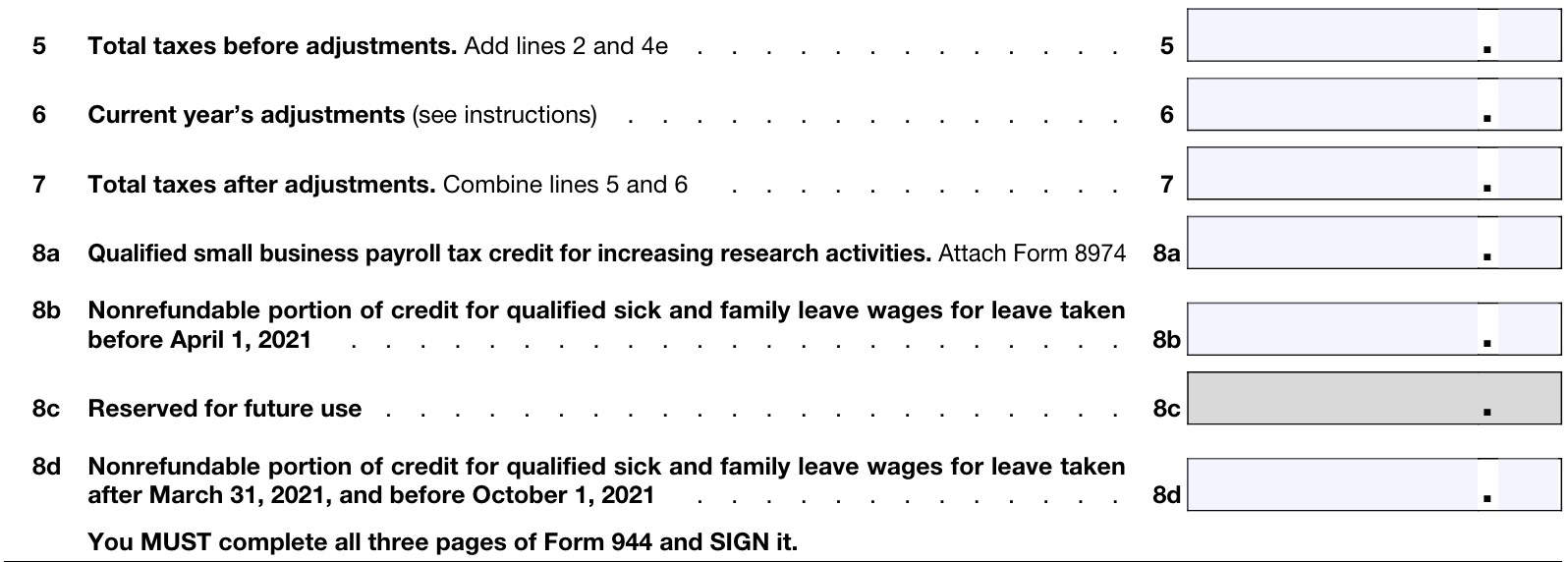
Line 7: Total taxes after adjustments
Combine lines 5 and 6, then enter the total here. This is the total amount of taxes you owe for the tax year, before applying any tax credits.
Line 8a: Qualified small business payroll tax credit for increasing research activities
In Line 11, enter the amount of the small business payroll tax credit for increasing research activities, as reported on IRS Form 8974. You can find this amount on either:
- Line 12: Credit against the employer share of social security tax
- Line 17: Total credit
If you enter an amount here, you must attach the completed Form 8974.
Line 8b: Nonrefundable portion of credit for qualified sick and family leave wages for leave taken before April 1, 2021
Complete Line 8b only if qualified sick leave wages and/or qualified family leave wages were paid during the tax year for leave taken after March 31, 2020, and before April 1, 2021.
As applicable, enter the nonrefundable portion of the credit for qualified sick and family leave wages from Worksheet 1, Step 2, Line 2j. You can find Worksheet 1 in the form instructions, located on the Internal Revenue Service website.
Line 8c: Reserved for future use
Do not enter anything here. This line is reserved for future use.
Line 8d: Nonrefundable portion of credit for qualified sick and family leave wages for leave taken after March 31, 2021, and before October 1, 2021
Complete Line 8d only if you paid qualified sick leave wages and/or qualified family leave wages were paid during the tax year for leave taken after March 31, 2021, and before October 1, 2021.
As applicable, enter the nonrefundable portion of the credit for qualified sick and family leave wages from Worksheet 2, Step 2, Line 2p. You can find Worksheet 2 in the form instructions, on the IRS website.
Line 8e: Reserved for future use
Do not enter anything here. This line is reserved for future use.
Line 8f: Reserved for future use
Do not enter anything here. This line is reserved for future use.
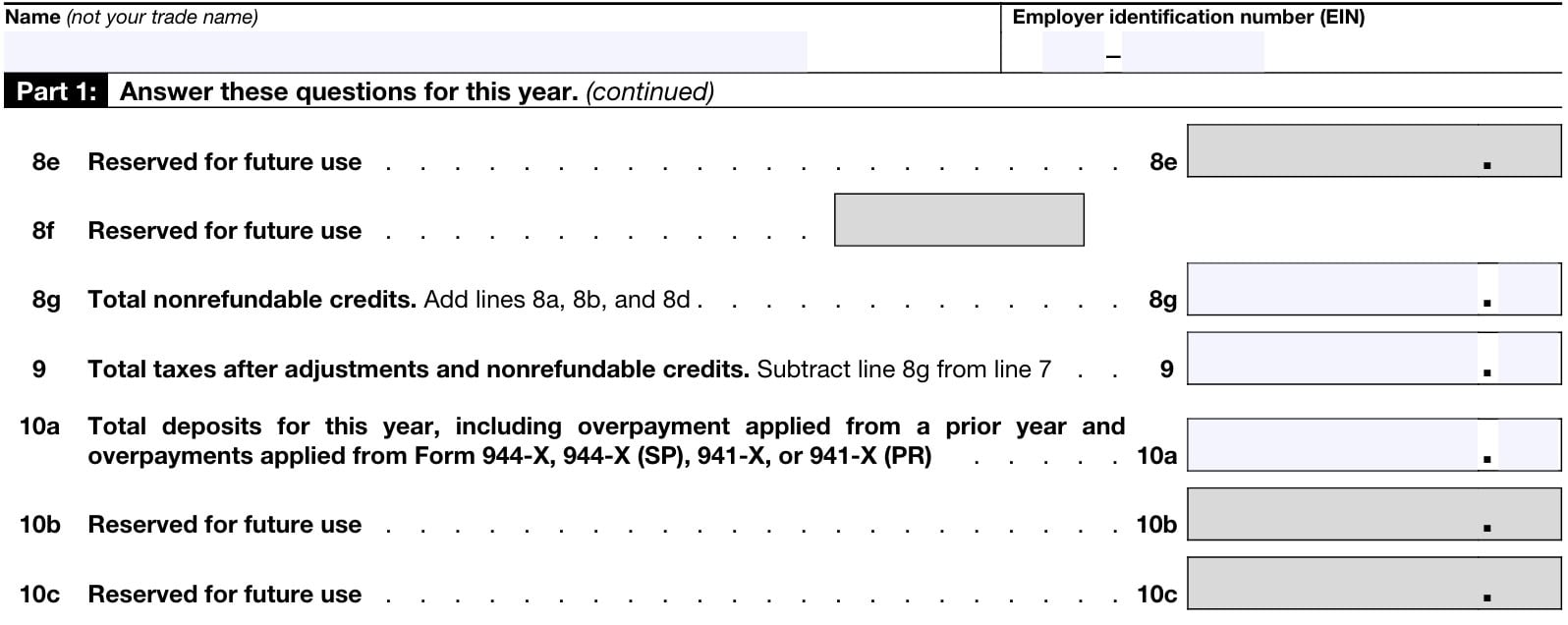
Line 8g: Total nonrefundable credits
Add Lines 8a, 8b, and 8d. This is the total amount of nonrefundable tax credits for the given year.
Line 9: Total taxes after adjustments and nonrefundable credits
Subtract Line 8g from Line 7. This represents your total taxes after making necessary adjustments and applying any nonrefundable tax credits.
If Line 9 is less than $2,500
When Line 9 is less than $2,500, you may pay the amount with Form 944 or you may deposit the amount using the Electronic Federal Tax Payment System, or EFTPS.
If Line 9 is $2,500 or greater
If Line 9 is $2,500 or more, you generally must deposit your tax liabilities via EFTPS. However, you may pay your fourth quarter taxes if:
- You deposited all taxes that you accumulated during the first 3 quarters of the year, and
- Your fourth quarter tax liability is less than $2,500
Line 10a: Total deposits for this year
Enter your tax deposits for this year. This includes any overpayment that you applied from filing any of the following:
- IRS Form 944-X, Adjusted Employer’s Annual Federal Tax Return or Claim for Refund
- IRS Form 944-X (SP)
- IRS Form 941-X, Adjusted Employer’s Quarterly Federal Tax Return or Claim for Refund
- IRS Form 941-X (PR), Adjusted Employer’s Quarterly Federal Tax Return or Claim for Refund (Puerto Rico Version)
Also, include any overpayment from a previous tax period that you applied to this return. However, do not include any amount that you did not deposit because you anticipated the tax credit for qualified sick and family leave wages.
Line 10b: Reserved for future use
Do not enter anything here. This line is reserved for future use.
Line 10c: Reserved for future use
Do not enter anything here. This line is reserved for future use.
Line 10d: Refundable portion of credit for qualified sick and family leave wages for leave taken before April 1, 2021
Complete Line 10d only if qualified sick leave wages and/or qualified family leave wages were paid during the tax year for leave taken after March 31, 2020, and before April 1, 2021.
As applicable, enter the refundable portion of the credit for qualified sick and family leave wages from Worksheet 1, Step 2, Line 2k.
Line 10e: Reserved for future use
Do not enter anything here. This line is reserved for future use.
Line 10f: Refundable portion of credit for qualified sick and family leave wages for leave taken after March 31, 2021, and before October 1, 2021
Complete Line 8d only if you paid qualified sick leave wages and/or qualified family leave wages were paid during the tax year for leave taken after March 31, 2021, and before October 1, 2021.
As applicable, enter the refundable portion of the credit for qualified sick and family leave wages from Worksheet 2, Step 2, Line 2q.
Line 10g: Reserved for future use
Do not enter anything here. This line is reserved for future use.
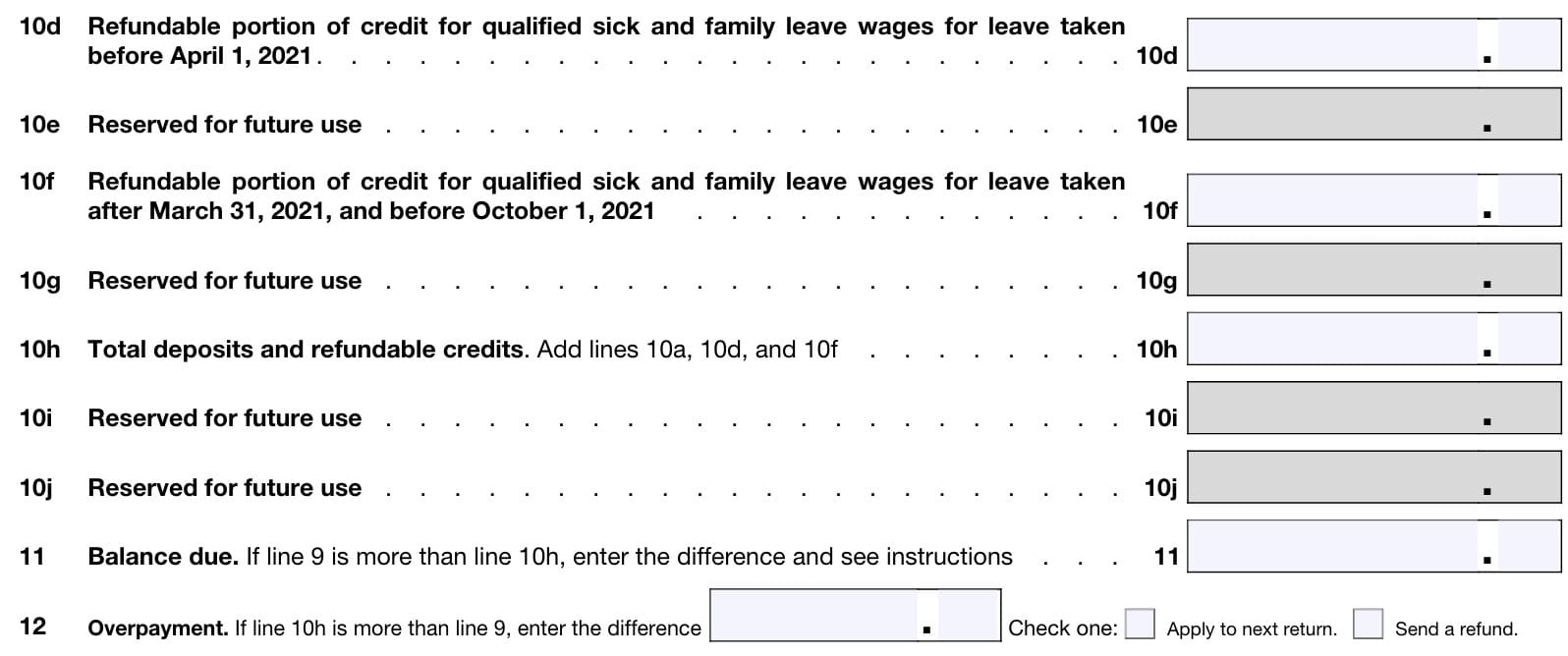
Line 10h: Total deposits and refundable credits
Add the following:
- Line 10a: Total deposits for this year
- Line 10d: Refundable portion of credit for qualified sick and family leave wages for leave taken before April 1, 2021
- Line 10f: Refundable portion of credit for qualified sick and family leave wages for leave taken after March 31, 2021, and before October 1, 2021
If Line 9 is greater than Line 10h, go to Line 11. If Line 10h is greater than Line 9, go to Line 12.
Line 10i: Reserved for future use
Do not enter anything here. This line is reserved for future use.
Line 10j: Reserved for future use
Do not enter anything here. This line is reserved for future use.
Line 11: Balance due
Subtract Line 10h from Line 9. Enter the difference here.
This represents the amount of your outstanding tax liability.
Line 12: Overpayment
Subtract Line 9 from Line 10h. Enter the difference here as a tax refund. Also, check the appropriate box:
- Apply to next return
- Send a refund
Let’s proceed to Part 2.
Part 2: Tell us about your deposit schedule and tax liability for the year
In Part 2, you’ll describe your deposit schedule and tax liability.
Line 13
If Line 9 is less than $2,500, then check the box and go to Part 3. You do not have to complete the rest of Part 2.
Otherwise, check the other box. You’ll then enter your tax liability for each month as follows:
- Line 13a: January
- Line 13b: February
- Line 13c: March
- Line 13d: April
- Line 13e: May
- Line 13f: June
- Line 13g: July
- Line 13h: August
- Line 13i: September
- Line 13j: October
- Line 13k: November
- Line 13l: December
Line 13m: Total tax liability for the year
Add Lines 13a through 13l. Enter the total here.
This amount must equal the amount reported in Line 9.
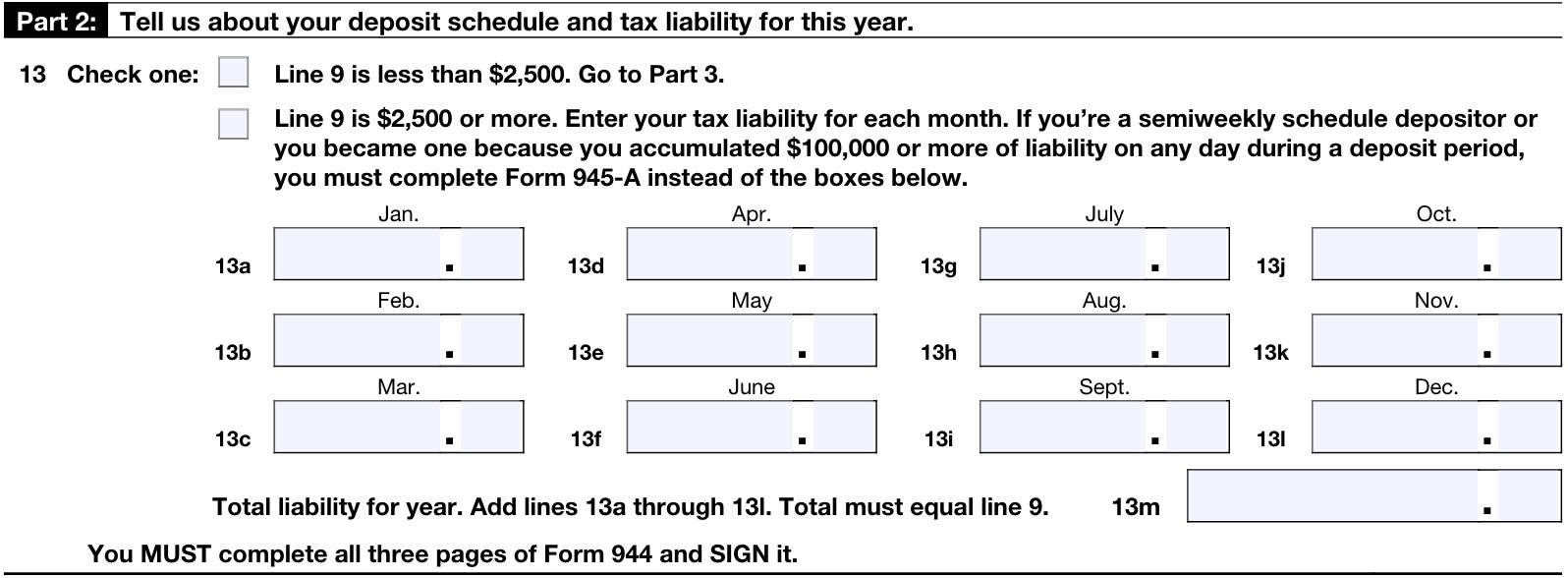
Part 3: Tell us about your business
In Part 3, you’ll answer specific IRS questions about your business. First, if your tax software does not already do this, you’ll need to enter your name and EIN at the top of this page.
If a particular question does not apply to your situation, leave the line blank.
Line 14: If your business has closed or you stopped paying wages
If you permanently go out of business or stop paying wages, you must file a final return.
To tell the IRS that a particular Form 944 is your final return, check the box on Line 14 and enter the date you last paid wages in the space provided.
Line 15: Qualified health plan expenses allocable to qualified sick leave wages for leave taken before April 1, 2021
Complete Lines 15 and 16 only if qualified health plan expenses allocable to qualified sick leave
wages and/or qualified family leave wages were:
- Paid in 2023 for leave taken:
- After March 31, 2020, and
- Before April 1, 2021
In Line 15, enter the qualified health plan expenses allocable to qualified sick leave wages paid in 2023 for leave taken after March 31, 2020, and before April 1, 2021.
Line 16: Qualified health plan expenses allocable to qualified family leave wages for leave taken before April 1, 2021
In Line 16, enter the qualified health plan expenses allocable to qualified family leave wages paid in 2023 for leave taken after March 31, 2020, and before April 1, 2021.
Line 17: Reserved for future use
Do not enter anything here. This line is reserved for future use.
Line 18: Reserved for future use
Do not enter anything here. This line is reserved for future use.
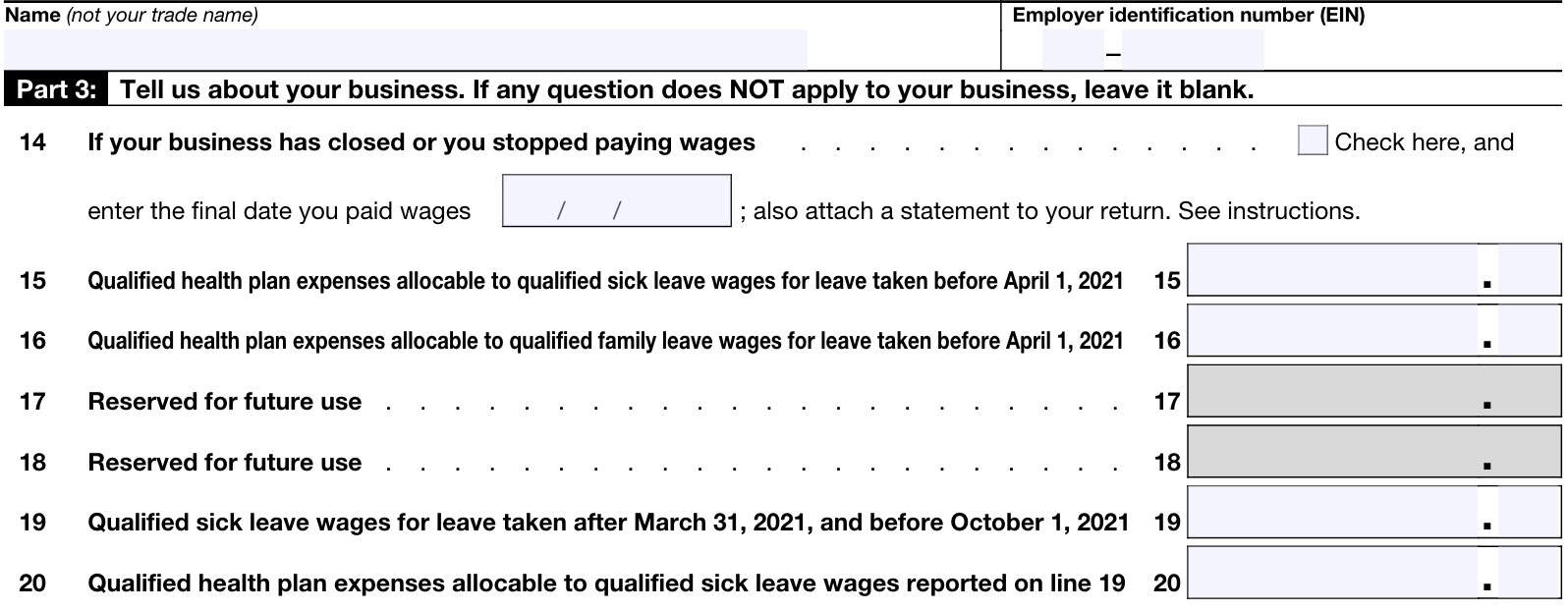
Line 19: Qualified sick leave wages for leave taken after March 31, 2021, and before October 1, 2021
Complete Lines 19, 20, and 21 only if qualified sick leave wages were:
- Paid in 2023 for leave taken:
- After March 31, 2021, and
- Before October 1, 2021
Enter the qualified sick leave wages you paid in 2023 to your employees for leave taken after March 31, 2021, and before October 1, 2021.
This includes any qualified sick leave wages that:
- Were above the Social Security wage base, or
- Excluded from the definition of employment under Internal Revenue Code Sections 3121(b)(1)-(22)
Line 20: Qualified health plan expenses allocable to qualified sick leave wages reported on line 19
Enter the qualified health plan expenses allocable to qualified sick leave wages paid in 2023 for leave taken after March 31, 2021, and before October 1, 2021.
Line 21: Amounts under certain collectively bargained agreements allocable to qualified sick leave wages reported on line 19
Enter any of the following that are allocable to qualified sick leave wages paid in 2023 for leave taken after March 31, 2021, and before October 1, 2021:
- Collectively bargained defined benefit pension plan contributions
- Collectively bargained apprenticeship program contributions

Line 22: Qualified family leave wages for leave taken after March 31, 2021, and before October 1, 2021
Complete Lines 22, 23, and 24 only if qualified family leave wages were:
- Paid in 2023 for leave taken:
- After March 31, 2021, and
- Before October 1, 2021
In Line 22, enter the qualified family leave wages you paid in 2023 to your employees for leave taken after March 31, 2021, and before October 1, 2021.
This includes any qualified family leave wages that:
- Were above the Social Security wage base, or
- Excluded from the definition of employment under Internal Revenue Code Sections 3121(b)(1)-(22)
Line 23: Qualified health plan expenses allocable to qualified family leave wages reported on line 22
Enter the qualified health plan expenses allocable to qualified family leave wages paid in 2023 for leave taken after March 31, 2021, and before October 1, 2021.
Line 24: Amounts under certain collectively bargained agreements allocable to qualified family leave wages reported on line 22
Enter any of the following that are allocable to qualified family leave wages paid in 2023 for leave taken after March 31, 2021, and before October 1, 2021:
- Collectively bargained defined benefit pension plan contributions
- Collectively bargained apprenticeship program contributions
Line 25: Reserved for future use
Do not enter anything here. This line is reserved for future use.
Line 26: Reserved for future use
Do not enter anything here. This line is reserved for future use.
Part 4: May we speak with your third-party designee?
If you want to allow an employee, a paid tax preparer, or another person to discuss your Form 944 with the IRS, check the “Yes” box in Part 4. If you check “Yes,” then enter the following information for the specific person:
- Name
- Phone number
- Five-digit personal identification number (PIN)

Do not use the name of your tax preparation firm. Your designee may choose any five numbers as the PIN.
By checking “Yes,” you authorize the IRS to talk to the person you named (your designee) about any questions that come up while processing your tax return. You also authorize your designee to do all of the following:
- Provide the IRS any missing information from your return
- Call the IRS for information about processing your return
- Respond to certain IRS notices that you’ve shared with your designee about math errors and return preparation.
The IRS will not send notices to your designee. You are not authorizing your designee to bind your company to any additional obligations or to represent you before the IRS. If you wish to expand your designee’s authorization, you can find additional details in IRS Publication 947, Practice Before the IRS and Power of Attorney.
This authorization automatically expires 1 year from the due date for filing your Form 944.
Part 5: Sign here
Under penalties of perjury, sign and date the form in Part 5. On the right-hand side, print your name and title, and enter a daytime telephone number.
The following individuals are authorized to sign Part 5, based upon the type of business entity.
Sole proprietorship
The business owner may sign.
Corporation
The president, vice president, or other principal officer duly authorized to sign on the corporation’s behalf. This includes any limited liability company (LLC) treated as a corporation.
Partnership
The president, vice president, or other duly authorized partner, member, or officer having knowledge of the partnership’s affairs can sign on the partnership’s behalf. This includes any LLC treated as a partnership or an unincorporated organization.
Single-member LLC
If treated as a disregarded entity for federal income tax purposes, then the owner or principal officer duly authorized to sign may sign IRS Form 944.
Trust or estate
The fiduciary may sign on behalf of the trust or estate.
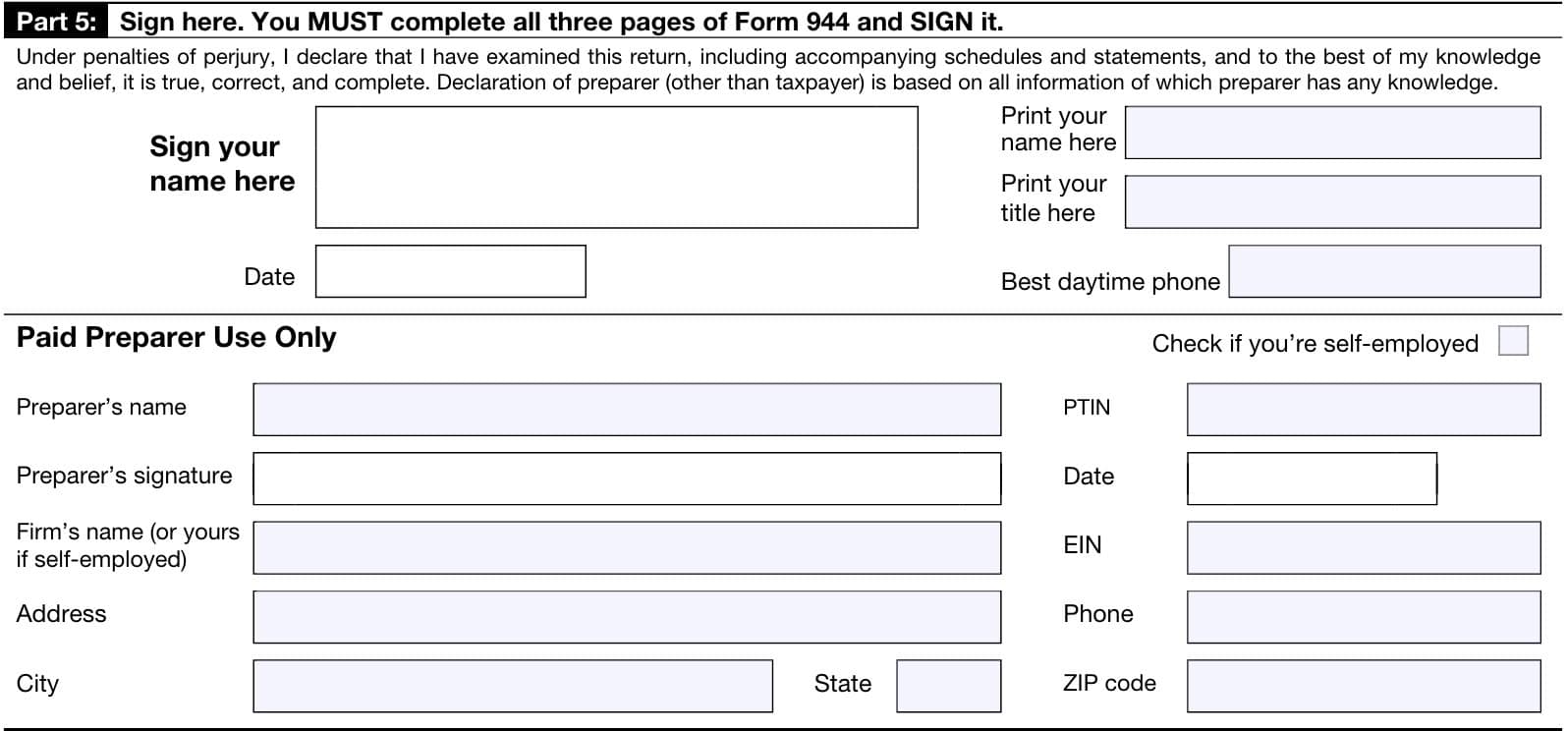
Filing considerations
Below are some additional filing considerations for IRS Form 944.
Who must file IRS Form 944?
In general, if the IRS has notified you to file Form 944, you must file Form 944 instead of quarterly Forms 941 to report the following amounts.
- Wages you have paid
- Tips your employees reported to you
- Federal income tax you withheld
- Both the employer and the employee share of Social Security and Medicare taxes
- Additional Medicare Tax withheld from employees
- Current year’s adjustments to social security and Medicare taxes for fractions of cents, sick pay, tips, and group-term life insurance
- Qualified small business payroll tax credit for increasing research activities
- Credit for qualified sick and family leave wages paid in 2023 for leave taken after March 31, 2020, and before October 1, 2021
You must file Form 944 if the IRS has notified you to do so, unless:
- The IRS notifies you to file quarterly Forms 941 instead, or
- You contact the IRS to request to file those forms and opt out of filing Form 944
When Is IRS Form 944 Due?
For 2023, the due date was January 31, 2024. However, if you made deposits on time in full payment of the taxes due for the year, the revised due date was February 12, 2024.
File Form 944 only once for each calendar year. If you filed Form 944 electronically, don’t file a paper Form 944.
How do I file IRS Form 944?
The IRS encourages taxpayers to file IRS Form 944 electronically through the IRS website.
Paper Filing
If filing by hard copy, use the following schedule based on location and whether or not you are submitting payment:
| If you’re filing in… | Without a payment | With a payment |
| Connecticut, Delaware, District of Columbia, Georgia, Illinois, Indiana, Kentucky, Maine, Maryland, Massachusetts, Michigan, New Hampshire, New Jersey, New York, North Carolina, Ohio, Pennsylvania, Rhode Island, South Carolina, Tennessee, Vermont, Virginia, West Virginia, Wisconsin | Department of the Treasury Internal Revenue Service Kansas City, MO 64999-0044 | Internal Revenue Service P.O. Box 806532 Cincinnati, OH 45280-6532 |
| Alabama, Alaska, Arizona, Arkansas, California, Colorado, Florida, Hawaii, Idaho, Iowa,Kansas, Louisiana, Minnesota, Mississippi, Missouri, Montana, Nebraska, Nevada, New Mexico, North Dakota, Oklahoma, Oregon, South Dakota, Texas, Utah, Washington, Wyoming | Department of the Treasury Internal Revenue Service Ogden, UT 84201-0044 | Internal Revenue Service P.O. Box 932100 Louisville, KY 40293-2100 |
| No legal residence or principal place of business in any state, including employers in American Samoa, Guam, the CNMI, the USVI, and Puerto Rico | Department of the Treasury Internal Revenue Service P.O. Box 409101 Ogden, UT 84409 | Internal Revenue Service P.O. Box 932100 Louisville, KY 40293-2100 |
| Special filing address for exempt organizations: federal, state, and local governmental entities; and Indian tribal governmental entities, regardless of location | Department of the Treasury Internal Revenue Service Ogden, UT 84201-0044 | Internal Revenue Service P.O. Box 932100 Louisville, KY 40293-2100 |
How do I pay my taxes when filing IRS Form 944?
If you were required to make federal tax deposits, then pay the amount shown on Line 11 by electronic funds transfer (EFT).
If you were not required to make federal tax deposits, or you’re a monthly schedule depositor making a payment under the accuracy of deposits rule, you may pay the amount shown on Line 11 by EFT, credit card, debit card, check, money order, or electronic funds withdrawal (EFW).
For more information on electronic payment options, go to IRS.gov/Payments.
If you pay by EFT, credit card, or debit card, file your return and don’t use Form 944-V, Payment Voucher.
Using IRS Form 944-V
If you pay by check or money order, then you should make it payable to “United States Treasury.”
Enter your EIN, “Form 944,” and the tax year on your check or money order.
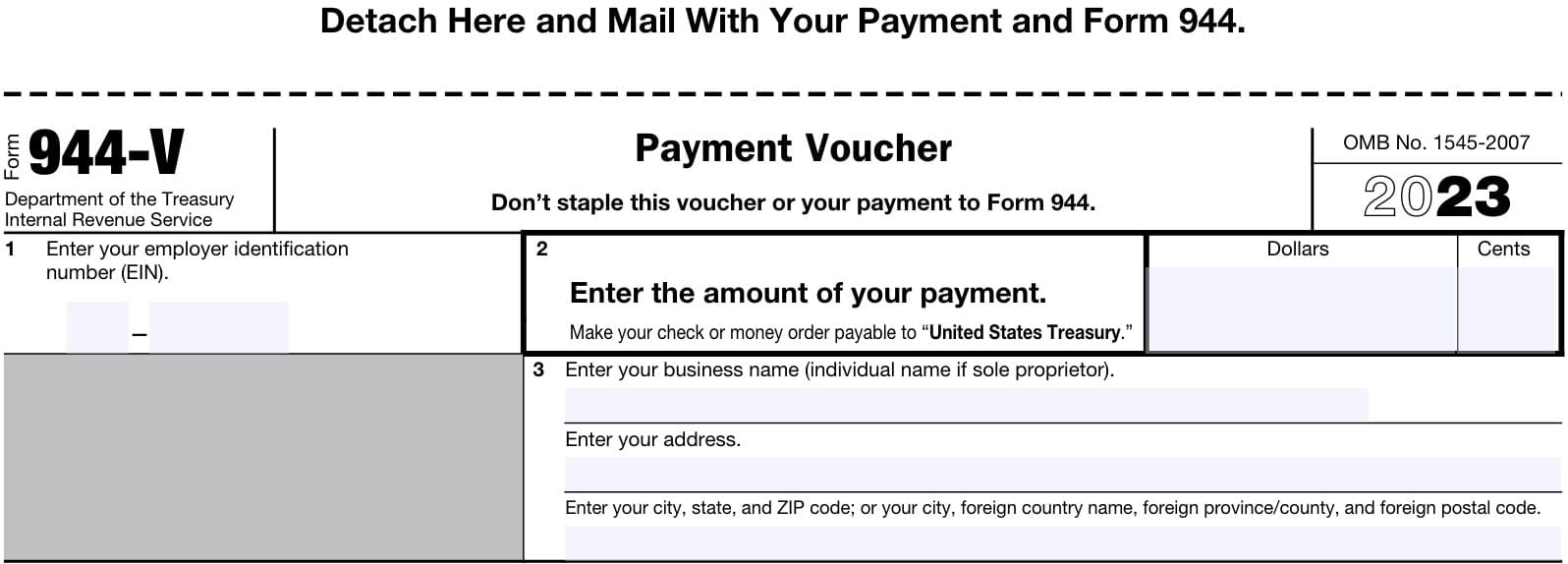
Complete Form 944-V and enclose it with Form 944.
Video walkthrough
Watch this video to learn more about IRS Form 944.
Frequently asked questions
IRS Form 944, Employer’s Annual Federal Tax Return, is used to report wages you’ve paid and tips your employees have reported to you, as well federal income tax withheld, Social Security and Medicare taxes withheld, and your share of Social Security and Medicare taxes paid to the IRS.
Generally, you must file a final Form 944 if you have stopped paying employees during the tax year, or if you permanently closed your business. To tell the IRS that Form 944 for a particular year is your final return, check the box on line 14 and enter the final date you paid wages.
Where can I find IRS Form 944?
As with other tax forms, you may find IRS Form 944 on the IRS website. For your convenience, we’ve enclosed the latest version of this form right here, in this article.


